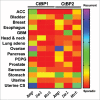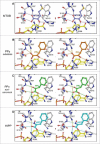CtBP- an emerging oncogene and novel small molecule drug target: Advances in the understanding of its oncogenic action and identification of therapeutic inhibitors
- PMID: 28532298
- PMCID: PMC5536941
- DOI: 10.1080/15384047.2017.1323586
CtBP- an emerging oncogene and novel small molecule drug target: Advances in the understanding of its oncogenic action and identification of therapeutic inhibitors
Abstract
C-terminal Binding Proteins (CtBP) 1 and 2 are oncogenic transcriptional co-regulators overexpressed in many cancer types, with their expression level correlating to worse prognostic outcomes and aggressive tumor features. CtBP negatively regulates the expression of many tumor suppressor genes, while coactivating genes that promote proliferation, epithelial-mesenchymal transition, and cancer stem cell self-renewal activity. In light of this evidence, the development of novel inhibitors that mitigate CtBP function may provide clinically actionable therapeutic tools. This review article focuses on the progress made in understanding CtBP structure, role in tumor progression, and discovery and development of CtBP inhibitors that target CtBP's dehydrogenase activity and other functions, with a focus on the theory and rationale behind the designs of current inhibitors. We provide insight into the future development and use of rational combination therapy that may further augment the efficacy of CtBP inhibitors, specifically addressing metastasis and cancer stem cell populations within tumors.
Keywords: C-terminal Binding Protein; CtBP; EMT; HIPP; MTOB; corepressor; dehydrogenase; oncogene; transcriptional co-regulator.
Figures






References
-
- Boyd JM, Subramanian T, Schaeper U, La Regina M, Bayley S, Chinnadurai G. A region in the C-terminus of adenovirus 2/5 E1a protein is required for association with a cellular phosphoprotein and important for the negative modulation of T24-ras mediated transformation, tumorigenesis and metastasis. EMBO J 1993; 12:469-78; PMID:8440238 - PMC - PubMed
-
- Schaeper U, Subramanian T, Lim L, Boyd JM, Chinnadurai G. Interaction between a cellular protein that binds to the C-terminal region of adenovirus E1A (CtBP) and a novel cellular protein is disrupted by E1A through a conserved PLDLS motif. J Biol Chem 1998; 273:8549-52; PMID:9535825; https://doi.org/10.1074/jbc.273.15.8549 - DOI - PubMed
-
- Chinnadurai G, Chinnadurai G. CtBP family proteins: Unique transcriptional regulators in the nucleus with diverse cytosolic functions. In: Madame Curie Bioscience Database. Austin (TX): Landes Bioscience; 2000–2013; https://doi.org/10.1007/978-0-387-39973-7_1 - DOI
-
- Hildebrand JD, Soriano P. Overlapping and unique roles for C-terminal binding protein 1 (CtBP1) and CtBP2 during mouse development. Mol Cell Biol 2002; 22:5296-307; PMID:12101226; https://doi.org/10.1128/MCB.22.15.5296-5307.2002 - DOI - PMC - PubMed
-
- Chinnadurai G. CtBP family proteins In: Chinnadurai G, ed. GtBP Family Proteins. New York, NY: Springer New York; 2007:1-17; https://doi.org/10.1007/978-0-387-39973-7_1 - DOI
Publication types
MeSH terms
Substances
LinkOut - more resources
Full Text Sources
Other Literature Sources
